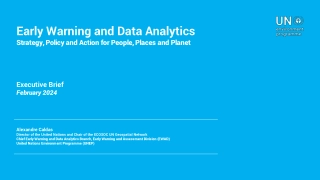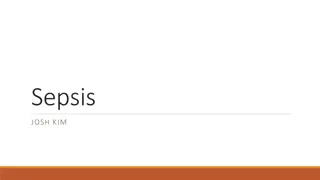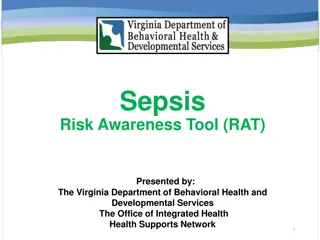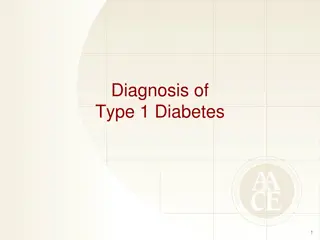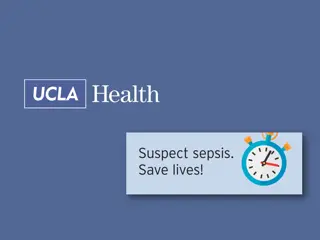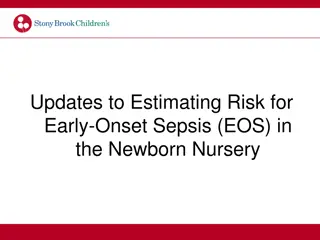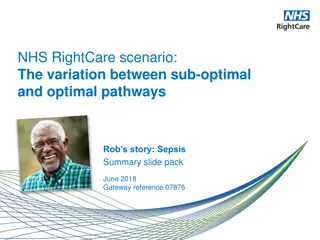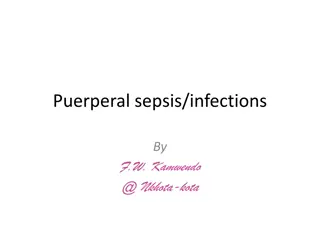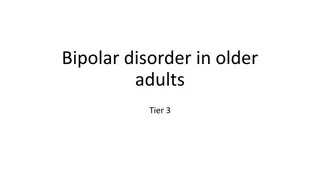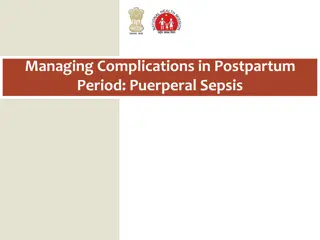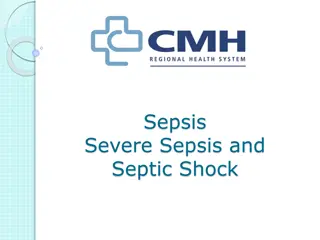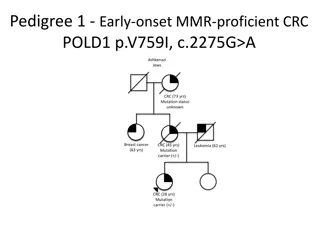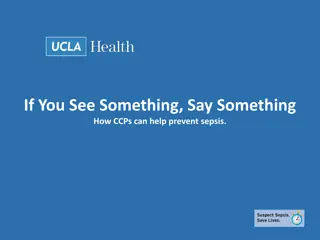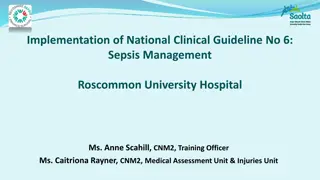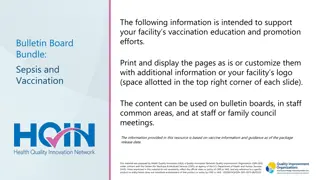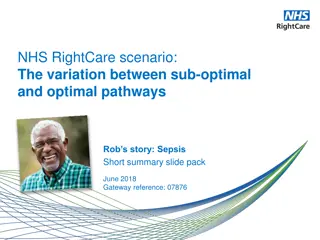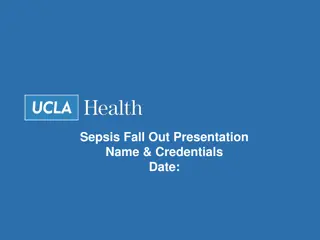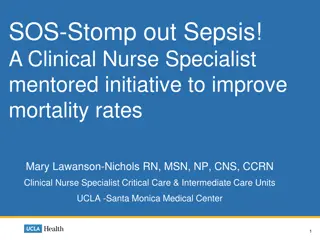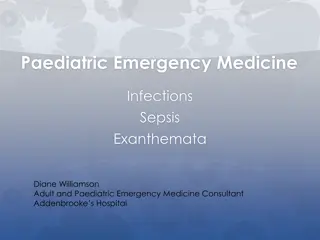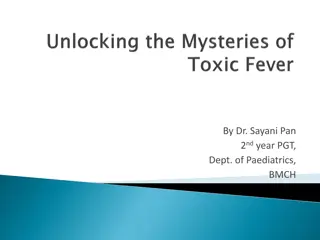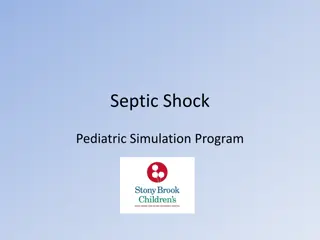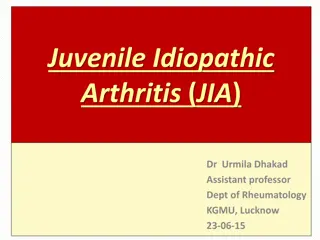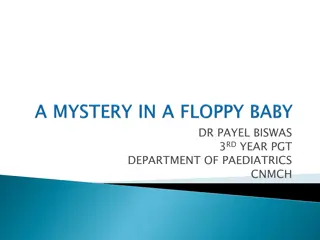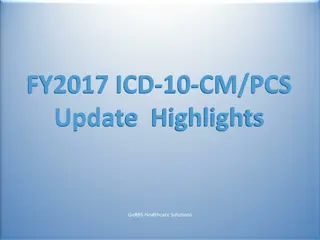Early Warning and Data Analytics Strategy, Policy and Action for People, Places and Planet
Explore the innovative Early Warning and Data Analytics Strategy introduced by the UN, focusing on leveraging early warning systems (EWS) to prepare for and manage hazardous climate-related events. This strategy aims to save lives, protect economies, and enhance sustainability by identifying, monito
1 views • 32 slides
Understanding Sepsis: Current Management Strategies and Global Efforts
Sepsis is a life-threatening infectious illness with significant global impact. The World Sepsis Declaration of 2012 underscores the need for improved recognition, prevention, and treatment strategies to address the high burden of sepsis worldwide. Efforts are being made to enhance management guidel
4 views • 118 slides
Case Study: Sepsis Presentation and Management in Two Patients
Mrs. NP, a 55-year-old woman with a background of cirrhosis from heavy alcohol use, presented to the ED with symptoms suggestive of sepsis. Examination revealed a febrile state, elevated blood pressure, and altered mental status. Investigations were initiated to determine the cause, with differentia
2 views • 41 slides
Enhancing Pediatric Care with the Irish Paediatric Early Warning System (PEWS)
The Irish Paediatric Early Warning System (PEWS) has been updated to align with National Sepsis Guidance in May 2023. It aims to assist in recognizing and responding to deterioration in pediatric patients, emphasizing the importance of clinical judgment and individualized assessment. PEWS does not r
1 views • 41 slides
Early Vasopressors in Sepsis Clinical Trial: Improving Patient Outcomes
This UK-wide clinical trial aims to assess the effectiveness of early peripheral norepinephrine infusion in adult patients with septic shock. The study will compare the impact on mortality and other outcomes of targeting a mean arterial pressure (MAP) above 65mmHg within the first 48 hours of admiss
1 views • 9 slides
Sepsis Risk Awareness Tool (RAT) Training Program Overview
The Sepsis Risk Awareness Tool (RAT) training program by The Virginia Department of Behavioral Health and Developmental Services aims to educate support coordinators, DSPs, and caregivers about the risk factors, signs, and symptoms of sepsis. It covers definitions, risk factors, signs, symptoms, dia
3 views • 22 slides
National Audit Results for Severe Sepsis and Septic Shock 2016/17
This presentation outlines the national results of a clinical audit conducted in 2016/17 regarding the management of severe sepsis and septic shock in Emergency Departments (EDs). The audit objectives include benchmarking current performance, facilitating national and peer comparisons, identifying a
0 views • 25 slides
Classification and Genetic Defects of Diabetes
The diagnosis and differential diagnosis of Type 1 and Type 2 diabetes are discussed, detailing the clinical courses, age of onset, body weight characteristics, onset patterns, and genetic factors. The etiologic classification of diabetes including insulin-deficient, immune-mediated, monogenic, and
0 views • 16 slides
Collaborating to Combat Sepsis: Role of Respiratory Therapists
Sepsis is a critical condition involving infection and inflammation, where the body's response causes widespread symptoms. Learn about the continuum of sepsis, its pathophysiology, and respiratory warning signs. Respiratory therapists play a crucial role in identifying and managing sepsis, with stat
1 views • 14 slides
Implementation of UCLA Sepsis BPA Functionality & Careplan
The UCLA Sepsis Best Practice Alert (BPA) system aids in creating timely and effective care plans for patients diagnosed with sepsis. This comprehensive guide covers the activation triggers, BPA location, creation process, and elements of the Sepsis Careplan, emphasizing the importance of early inte
1 views • 16 slides
Understanding Early-Onset Sepsis (EOS) Risk Factors and Management in Newborns
Neonatal Early-Onset Sepsis (EOS) is a rare but life-threatening condition primarily caused by Group B Streptococcus (GBS) or Escherichia coli. Recognizing risk factors such as maternal age, intrapartum fever, GBS colonization, and certain neonatal characteristics is crucial for timely evaluation an
0 views • 26 slides
Improving Sepsis Care Pathways: Rob's Story Highlights Areas for Enhancement
Rob's journey through a sub-optimal sepsis care pathway sheds light on crucial areas for improvement, such as insufficient education, poor communication, tracking issues, and serious implications leading to family distress and legal challenges. The story emphasizes the importance of timely and effec
1 views • 11 slides
Prevention and Management of Puerperal Sepsis and Infections
Puerperal sepsis and infections are serious conditions affecting women postpartum. Puerperal sepsis is characterized by specific symptoms, while puerperal infections are more general. Prevention includes antenatal care, strict intrapartum hygiene practices, and timely interventions. By following gui
2 views • 8 slides
Understanding Bipolar Disorder in Older Adults
Bipolar disorder in older adults can have a later onset, often after the age of 50, with episodes of mania and depression. Recognizing symptoms like excessive energy, inability to sleep, and cognitive impairment is crucial. Late-onset bipolar disorder differs from early-onset in familial illness rat
1 views • 12 slides
Managing Complications in Postpartum Period: Puerperal Sepsis Overview
Puerperal sepsis, a leading cause of maternal death, can be prevented through hygiene practices and early identification. Learn about the risk factors, diagnosis, and prevention strategies for maternal sepsis in the postpartum period.
3 views • 9 slides
Biomarker-Guided Antibiotic Duration in Sepsis Patients
This research focuses on evaluating the safety and efficacy of a biomarker-guided approach to determine the duration of antibiotic treatment in hospitalized adult patients with sepsis. The study involves a multi-centre randomized controlled trial to assess if a treatment protocol based on monitoring
0 views • 53 slides
Understanding Puberty: Physiology, Changes, and Management
Puberty is a normal physiological process marking the transition from childhood to sexual maturity. Understanding its physiology, factors influencing it, physical changes, stages of development, onset, and precocious puberty is essential for proper diagnosis and management. Various factors like race
1 views • 24 slides
Understanding Sepsis and Its Impact on Patient Care
Sepsis is a life-threatening condition resulting from the body's response to an infection, leading to shock, multiple organ failure, and potentially death if left untreated. Recognizing and treating sepsis promptly is crucial, as it has a high mortality rate and can have a significant impact on pati
1 views • 21 slides
Familial Colorectal Cancer Syndromes: Genetic Profiles and Clinical Presentations
These pedigrees depict familial colorectal cancer syndromes in Ashkenazi and Iraqi Jews, showcasing early-onset MMR-proficient CRC cases linked to mutations in POLD1 and POLE genes. The pedigrees detail various cancer diagnoses, mutation carrier statuses, and ages of onset across multiple generation
0 views • 5 slides
Understanding Young Onset Dementia: Assessment and Diagnosis Webinar
In this informative webinar led by Dr. Janet Carter and other experts, various aspects of young onset dementia are explored, including typical presentations, key red flags in history, required investigations, genetic testing importance, and social implications. The session delves into the unique cha
1 views • 35 slides
Warsaw International Mechanism for Loss and Damage: Addressing Climate Change Impacts
The Warsaw International Mechanism for Loss and Damage focuses on addressing climate change impacts, including extreme events and slow-onset events, in vulnerable developing countries. Through its Executive Committee, the mechanism aims to enhance dialogue, understanding, and action to support those
2 views • 11 slides
Overview of OCDEL - Pennsylvania's Early Learning Programs
The Office of Child Development and Early Learning (OCDEL) in Pennsylvania plays a vital role in promoting high-quality child and family services. It oversees various bureaus responsible for early learning opportunities, child care works, certification, and early intervention. PELICAN, an integrated
0 views • 25 slides
Understanding and Preventing Sepsis: Vital Information for Caregivers
Sepsis is a life-threatening condition caused by the body's response to infection. Learn about the symptoms, prevention strategies, and how to recognize and respond to sepsis in a healthcare setting. The importance of reporting vital signs accurately and understanding patient behavior is also highli
1 views • 9 slides
Implementation of Sepsis Management Guidelines at Roscommon University Hospital
Sepsis, a life-threatening condition, necessitates timely management for improved outcomes. Roscommon University Hospital implemented the Sepsis Screening Program in 2016 with the objective of standardizing practices, educating teams, and assessing outcomes. The initiative includes training, tool im
1 views • 18 slides
Non-Pharmacologic Treatments in Precision Pain Medicine: Splitting vs. Lumping Criteria
This article discusses the rationale behind splitting (stratifying) versus lumping patients in precision pain medicine. It explores criteria for stratifying patients based on demographic, genetics, biomedical mechanisms, clinical presentation, etiological factors, and psychological response to treat
0 views • 35 slides
Importance of Vaccinations in Sepsis Prevention
Sepsis is a life-threatening response to infection that can lead to organ failure and death. Infection prevention through vaccinations is crucial to combat sepsis. Best practices include obtaining vaccination consent, offering education, and co-administering vaccines to older adults. Accessing vacci
1 views • 8 slides
Contrasting Pathways in Sepsis Care: Rob's Journey
Rob's story illustrates the stark contrast between sub-optimal and optimal pathways in managing sepsis. Delayed recognition and treatment in the sub-optimal pathway led to severe complications, whereas timely intervention in the optimal pathway resulted in improved outcomes. The importance of early
1 views • 7 slides
Physiology of Labor: Onset and Key Hormonal Changes
Labor, or parturition, involves uterine contractions leading to the fetus's expulsion. Factors triggering labor include hormonal changes like increased estrogen and decreased progesterone, which stimulate uterine muscle activity. Telocytes play a role in spontaneous uterine activity, while oxytocin
0 views • 36 slides
Sepsis Fallout Presentation - Managing Severe Sepsis and Septic Shock
This presentation template guides healthcare professionals on effectively managing severe sepsis and septic shock cases, emphasizing prompt recognition and appropriate interventions. It includes sections on patient background, sepsis criteria, treatment protocols, and debriefing discussions for cont
0 views • 7 slides
Improving Mortality Rates in Sepsis Patients: A Clinical Nurse Specialist Initiative
Clinical Nurse Specialist, Mary Lawanson-Nichols, initiated a program at UCLA-Santa Monica Medical Center to reduce mortality rates in sepsis patients. By focusing on mentoring skills, leadership development for staff nurses, and examining influences on mortality, the program aims to make a signific
0 views • 24 slides
Study on Young Onset Colorectal Cancer in Southwest England
The study focuses on young adults under 50 diagnosed with colorectal cancer in the Somerset, Wiltshire, Avon, and Gloucestershire regions. It aims to capture data on their epidemiology, diagnostic pathways, management, and outcomes from 2009 to 2019. The background and incidence trends both globally
0 views • 24 slides
Quality Control and Testing Procedures for Superconducting Radiofrequency Cavities
The presentation highlights the rigorous processes involved in qualifying superconducting radiofrequency (SRF) cavities for high-performance applications. Each cavity undergoes a detailed qualification process, including BCP treatment, electropolishing, and high-pressure rinsing, to ensure optimal p
0 views • 18 slides
Northern Rivers Wellbeing Program & Digital Training for Women: Empowering Individuals Living with Dementia
Explore the comprehensive programs offered by the Northern Rivers Wellbeing Program and Digital Training for Women initiative, focusing on empowering individuals living with young onset dementia. Engage in digital safety surveys, free training sessions, and interactive discussions about young onset
0 views • 8 slides
Paediatric Emergency Medicine Overview: Infections, Sepsis, Exanthemata, and Warning Signs
Paediatric emergency medicine involves assessing and managing various conditions in children, such as infections, sepsis, and exanthemata. This overview covers the evaluation of febrile children, warning signs indicating potential serious illness, and the importance of thorough examination and asses
0 views • 48 slides
Case Study: Infant with Persistent Fever and Cry
Aditi Malakar, a 2-month-old female infant, presented with a remittent fever persisting for 9 days unresponsive to antipyretics, along with persistent crying and decreased feeding for the last 2 days. She was referred to the hospital after being diagnosed with sepsis elsewhere. Aditi had a history o
0 views • 31 slides
Management Strategies for Pediatric Septic Shock Simulation Program
This content provides information on the management of sepsis, including recognition, supportive care, source control, antibiotics, and specific therapies. It emphasizes the importance of initial resuscitation goals, strategies involving fluid resuscitation, inotropic support, and timely administrat
0 views • 12 slides
Understanding Juvenile Idiopathic Arthritis (JIA) and Systemic Onset JIA (SOJIA)
Juvenile Idiopathic Arthritis (JIA) is arthritis of unknown origin that starts before the 16th birthday and lasts at least 6 weeks. It was previously known as juvenile rheumatoid arthritis (JRA). The diagnosis of JIA requires meeting specific criteria, and it can be classified into various subtypes
0 views • 52 slides
Approach to Acute Flaccid Paralysis in Children: Evaluation and Management
Acute muscular weakness in children is a neurological emergency defined by sudden onset muscle weakness or paralysis in less than 5 days. When evaluating a child with acute flaccid paralysis, consider factors like onset rhythm, associated symptoms, and past medical history. A thorough physical and n
0 views • 45 slides
Differential Diagnosis of Infant with Sudden Onset Weakness and Neurological Symptoms
A 2-month-old infant presented with sudden onset weakness in all four limbs following an upper respiratory tract infection. Clinical findings include froglike posture, diminished tone in all limbs, absent reflexes, and cranial nerve involvement. Possibilities include brainstem encephalitis, myelitis
0 views • 29 slides
Updates and Highlights in FY2017 ICD-10-CM/PCS
In the FY2017 update of ICD-10-CM/PCS, significant changes have been made with new codes, updates, and deletions affecting coding diagnoses. The update includes coding highlights related to various conditions like bacteriuria, sepsis, pre-diabetes, and Zika virus. The Third International Consensus D
0 views • 30 slides
